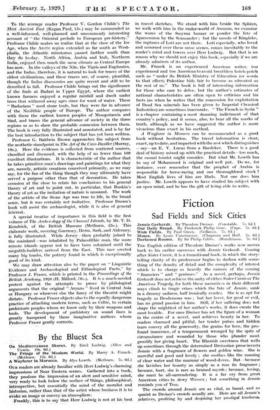Man's Beginnings
NEVER did educated man take so lively an interest in his origins as he shows at present. The study of prehistory is being energetically pursued by the civilized nations, and books are multiplying at a rapid pace—too rapid, indeed, when the information available has not been well digested. The latest book, The Travels and Settlements of Early Man, by Mr. T. S. Foster (Ernest Benn, 21s.), is one of the most ambitious. Mr. Foster, who is Reader in Education at Bristol University, holds that we ought to study uncivilized education as a warning or example and that we should investigate the customs of the backward races so that we may help them to improve. For these reasons he embarks on a survey of the development of the apes through millions of years, and of primitive man from the time when, on this theory, he emerged or became differentiated from the ape. His chapter on the Old Stone Age is entitled " Savage Europe " and the following chapter is headed " The Coming of Sapiens," though there is no adequate reason for drawing so clear a distinction between the alleged unwisclorn, of the Mousterians and the reputed wisdom of the Aurignacians. Mr. Foster is perhaps too ready to develop soefological theories from archaeological facts.
His next chapters on " The Near East " and " Barbarous Europe " sketch the progress of man to the dawn of written history in a suggestive but not very lucid fashion. He then diverges to America and the Pacific, and those who are, for or against Professor Elliot Smith and Mr. W. J. Perry may be told that Mr. Foster is much impressed by the theory of the megalith-builders advancing eastward to civilize Eastern Asia, the PaCific Islands and America. Those who know a good deal about prehistory will find Mr. Foster's book stimulating. To Mt average reader Professor V. Gordon Childe's The Most Ancient East (Began- Paul, 15s.) may be commended as a well-informed, well-planned and uncommonly interesting account of " the Oriental prelude to European pre-history." Professor Childe makes us realize that at the close of the Ice Age, when the Arctic region extended as far south as West- phalia, the Atlantic rainstorms passed farther south than they do to-day. North Africa, Arabia and Irak, Northern India, enjoyed then much the same climate as Central Europe has now. ,In_the.valleys of the Nile, the Tigris and Euphrates, and the Indus, therefore, it is natural to look for traces of the oldest civilizations, and these traces are, of course, plentiful, though the Indus discoveries are quite recent and still to be described in full. Professor Childe brings out the significance of the finds at Badari in Upper Egypt, where the earliest known farmers enjoyed a regular rainfall and dwelt under trees that withered away ages since for want of water. These " Badarians " used stone tools, but they were far in advance of the Neolithic people of Europe. ' The author compares with them the earliest known peoples of Mesopotamia and Sind, and traces the general advance of society in the three regions so as to show the probable .connexion between them. The book is very fully illustrated and annotated, and is by far the best introduction to the subject that has-yet been written.
Professor G. Baldwin Brown approaches the subject from the aesthetic standpoint in .The Art of the Cave-Dweller (Murray, 18s.). Here the evidence is collected from scattered sources, classified and discussed, with the help of no fewer than 169 excellent illustrations. It is characteristic of the author that he takes primitive man's drawings and paintings for what they are, namely, artistic creations conceived primarily, as we may say, for the fun of the thing though they may ultimately have served a purpose other than that of decoration. He takes occasion at the close to relate his conclusions to his general theory of art and to point out, in particular, that Ruskin's theory of art as the imitation of nature is unsound. The work of the artists of the Stone Age was true to life, in the broad sense, but it was certainly not imitative. Professor Brown's book will assist the archaeologist, while it is also of general interest.
A special treatise of importance in this field is the first volume of The Archceelogy of the Channel Islands, by Mr. T. D. Kendrick, of the British Museum (Methuen, 25s.). This elaborate work,. covering Guernsey, Herm, Sark, and Alderney, is fully illuStrated. While Jersey—then probably joined to the mainland—was inhabited by Palaeolithic man, the more remote islands appear not to have been colonized until the megalith-builders arrived from the East. This race erected many big tombs, tfie pottery found in which is exceptionally good of its kind.
We may draw attention also to the paper on " Linguistic Evidence and Archaeological and Ethnological Facts," by Professor J. Fraser, which is printed in the Proceedings of the British Academy, 1926 (H. Milford, Mi.). It is a much-needed protest against the attempts to prove by philological arguments that the original " Aryans " lived in Central Asia or Hungary or wherever else the fancy of the theorist might dictate. Professor Fraser objects also to the equally dangerous practice of attaching modern terms, such as Celtic, to certain prehistoric peoples whom we know only by their weapons and tools. The development of prehistory on sound lines is greatly hampered by those imaginative authors whom Professor Fraser gently corrects.









































 Previous page
Previous page